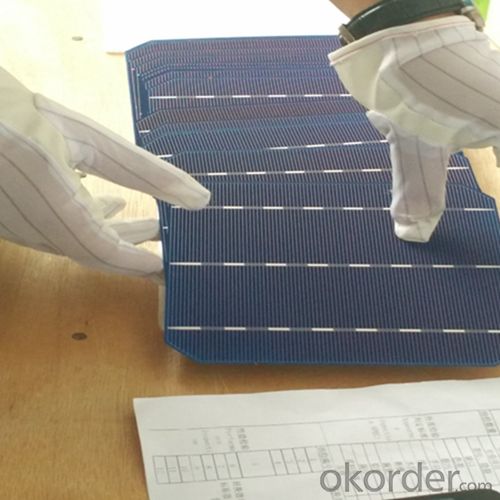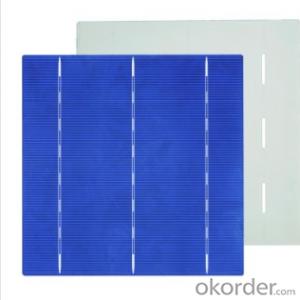Poly 156x156mm2 Solar Cells Made Class A - Solar Cells At Night
- Loading Port:
- Shanghai
- Payment Terms:
- TT OR LC
- Min Order Qty:
- 6500 watt
- Supply Capability:
- 6000000 watt/month
OKorder Service Pledge
OKorder Financial Service
You Might Also Like
The operation of a photovoltaic (PV) cell requires 3 basic attributes:
The absorption of light, generating either electron-hole pairs or excitons.
The separation of charge carriers of opposite types.
The separate extraction of those carriers to an external circuit.
In contrast, a solar thermal collector supplies heat by absorbing sunlight, for the purpose of either direct heating or indirect electrical power generation from heat. A "photoelectrolytic cell" (photoelectrochemical cell), on the other hand, refers either to a type of photovoltaic cell (like that developed by Edmond Becquerel and modern dye-sensitized solar cells), or to a device that splits water directly into hydrogen and oxygen using only solar illumination.Characteristic of Mono 156X156MM2 Solar Cells
You are gaining energy independence - add battery backup power for even greater energy security
The cost of electricity is only going to rise – insure against that rising cost
Adaptive cells change their absorption/reflection characteristics depending to respond to environmental conditions. An adaptive material responds to the intensity and angle of incident light. At the part of the cell where the light is most intense, the cell surface changes from reflective to adaptive, allowing the light to penetrate the cell. The other parts of the cell remain reflective increasing the retention of the absorbed light within the cell.[67]
In 2014 a system that combined an adaptive surface with a glass substrate that redirect the absorbed to a light absorber on the edges of the sheet. The system also included an array of fixed lenses/mirrors to concentrate light onto the adaptive surface. As the day continues, the concentrated light moves along the surface of the cell. That surface switches from reflective to adaptive when the light is most concentrated and back to reflective after the light moves along
Mechanical data and design
Format | 156mm x 156mm±0.5mm |
Thickness | 210μm±40μm |
Front(-) | 1.5mm bus bar (silver),blue anti-reflection coating (silicon nitride) |
Back (+) | 2.5mm wide soldering pads (sliver) back surface field (aluminium) |
Temperature Coefficient of Cells
Voc. Temp.coef.%/K | -0.35% |
Isc. Temp.coef .%/K | +0.024%/K |
Pm.Temp.coef. %/K | -0.47%/K |
Electrical Characteristic
Effiency(%) | Pmpp(W) | Umpp(V) | Impp(A) | Uoc(V) | Isc(A) | FF(%) |
18.35 | 4.384 | 0.526 | 8.333 | 0.63 | 8.877 | 78.39% |
18.20 | 4.349 | 0.526 | 8.263 | 0.63 | 8.789 | 78.54% |
18.05 | 4.313 | 0.525 | 8.216 | 0.63 | 8.741 | 78.32% |
17.90 | 4.277 | 0.524 | 8.161 | 0.625 | 8.713 | 78.04% |
17.75 | 4.241 | 0.523 | 8.116 | 0.625 | 8.678 | 77.70% |
17.60 | 4.206 | 0.521 | 8.073 | 0.625 | 8.657 | 77.36% |
17.45 | 4.170 | 0.519 | 8.039 | 0.625 | 8.633 | 76.92% |
17.30 | 4.134 | 0.517 | 8.004 | 0.625 | 8.622 | 76.59% |
17.15 | 4.096 | 0.516 | 7.938 | 0.625 | 8.537 | 76.80% |
17.00 | 4.062 | 0.512 | 7.933 | 0.625 | 8.531 | 76.18% |
16.75 | 4.002 | 0.511 | 7.828 | 0.625 | 8.499 | 75.34% |
16.50 | 3.940 | 0.510 | 7.731 | 0.625 | 8.484 | 74.36% |




 FAQ
FAQ
Q: What price for each watt?
A: It depends on the quantity, delivery date and payment terms, generally Large Quantity and Low Price
Q: What is your size for each module? Can you tell me the Parameter of your module?
A: We have different series of panels in different output, both c-Si and a-Si. Please take the specification sheet for your reference.
Q: What is your size for each module? Can you tell me the Parameter of your module?
A: We have different series of panels in different output, both c-Si and a-Si. Please take the specification sheet for your reference.
- Q: Can solar cells be used in ski resorts for snowmaking?
- Yes, solar cells can be used in ski resorts for snowmaking. Solar cells can generate electricity from sunlight, which can then be used to power the snowmaking equipment. This can help reduce the reliance on fossil fuels and contribute to a more sustainable and environmentally friendly snowmaking process.
- Q: Can solar cells be used for off-grid power systems?
- Yes, solar cells can be used for off-grid power systems. Solar cells convert sunlight directly into electricity, allowing them to generate power in remote locations or areas without access to the traditional power grid. They are particularly well-suited for off-grid power systems as they are reliable, renewable, and require minimal maintenance. Additionally, advancements in battery storage technology have made it possible to store excess energy generated by solar cells for use during periods of low or no sunlight, further enhancing their suitability for off-grid applications.
- Q: Can solar cells be used in powering irrigation systems?
- Yes, solar cells can be used to power irrigation systems. Solar panels convert sunlight into electricity, which can be used to power pumps or other necessary components of irrigation systems. This offers a sustainable and cost-effective solution for providing power to irrigation systems in areas with limited access to electricity.
- Q: Can solar cells be used in water purification systems?
- Yes, solar cells can be used in water purification systems. Solar cells can generate electricity from sunlight, which can be used to power various components of water purification systems, such as pumps, filters, and disinfection devices. This allows for sustainable and environmentally-friendly water purification solutions, especially in areas with limited access to electricity grids.
- Q: Can solar cells be used in sports arenas?
- Yes, solar cells can be used in sports arenas. They can be installed on the rooftops or canopies of the arenas to generate renewable energy. This not only helps in reducing the carbon footprint of the venue but also provides sustainable power for various operations within the arena, such as lighting, heating, and cooling systems. Additionally, solar cells can also be used to power electronic devices and scoreboards in sports arenas, making them more energy-efficient and environmentally friendly.
- Q: Can solar cells be used for powering remote sensing devices?
- Yes, solar cells can be used to power remote sensing devices. Solar cells convert sunlight into electricity, which can then be used to power various electronic devices, including remote sensing devices. This renewable energy source is particularly advantageous for remote sensing applications as it eliminates the need for traditional power sources and allows for greater flexibility and portability in remote locations.
- Q: What are the safety considerations when installing solar cells?
- When installing solar cells, it is important to consider several safety precautions. First and foremost, it is essential to work with a qualified and experienced installer who understands the necessary safety protocols. Additionally, proper electrical safety measures should be taken, such as turning off the power supply and using insulated tools. It is crucial to follow all manufacturer instructions and guidelines to ensure safe installation. Working at heights should also be approached with caution, using appropriate fall protection equipment when necessary. Lastly, it is important to be aware of potential hazards such as sharp edges, hot surfaces, and electrical shock risks. Regular maintenance and inspections should be conducted to ensure ongoing safety.
- Q: How much electricity can a solar cell generate?
- The amount of electricity a solar cell can generate depends on various factors including the size and efficiency of the cell, the intensity of sunlight, and the duration of exposure. On average, a typical solar cell can generate around 200 to 400 watts of electricity per square meter under optimal conditions.
- Q: Can solar cells be used to power water pumps or irrigation systems?
- Yes, solar cells can be used to power water pumps or irrigation systems. Solar panels convert sunlight into electricity, which can then be used to power water pumps and irrigation systems, providing a sustainable and renewable source of energy.
- Q: What is the role of bypass diodes in shading situations?
- The role of bypass diodes in shading situations is to minimize the impact of shade or partial shading on the performance of solar panels. When a solar panel is partially shaded, the shaded cells can create a significant drop in voltage, reducing the overall electrical output. Bypass diodes are connected in parallel with the shaded cells, allowing the current to bypass the shaded area and flow through the diode. This helps to maintain a higher voltage and prevent the shaded cells from negatively affecting the performance of the entire solar panel.
Send your message to us
Poly 156x156mm2 Solar Cells Made Class A - Solar Cells At Night
- Loading Port:
- Shanghai
- Payment Terms:
- TT OR LC
- Min Order Qty:
- 6500 watt
- Supply Capability:
- 6000000 watt/month
OKorder Service Pledge
OKorder Financial Service
Similar products
Hot products
Hot Searches
Related keywords



























